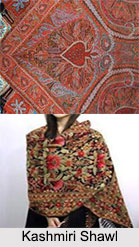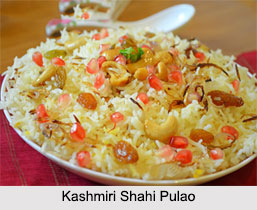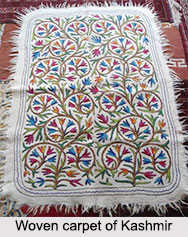 Culture of Jammu and Kashmir depicts the rich art and architecture and the culture of medieval era, which is now the epitome. The culture of Jammu and Kashmir is distinct and diverse, encompassing the various habits and lifestyles of the people inhabiting the regions of Jammu, Kashmir and Ladakh.
Culture of Jammu and Kashmir depicts the rich art and architecture and the culture of medieval era, which is now the epitome. The culture of Jammu and Kashmir is distinct and diverse, encompassing the various habits and lifestyles of the people inhabiting the regions of Jammu, Kashmir and Ladakh.
During their long periods of independence, isolation and solidarity, the people of Kashmir developed a unique culture making everlasting contributions to learning and literature.
The Valley of Kashmir which is surrounded by the snow-clad Himalayas is one of the most beautiful spots in the world because of vast expanse of flat country with rich alluvial soil, lofty and glacial mountains, crystal streams, lofty crags, torrents, broad lakes, shady Chinar groves and pine forests.
Costumes of Jammu and Kashmir
The dress of Jammu and Kashmir essentially comprises of a long loose gown buttoning at the neck and falling to the ankles. In winter it is made of wool and in summer of cotton. There is very little difference between the pheran worn by men and women. A pyjama of the loose type is generally worn under the pheran and this is all the dress of an average villager. The women wear a skull cap surrounded by a fillet of red colour in the case of Muslim and a fillet of white cloth in the case of Pandit women. A shawl or a white `chaddar` thrown gracefully over the head and shoulders, more as a protection from the sun than to hide the features, completes their headgear. Men wear turbans as a sign of respectability and affluence. Among certain classes, women can also be seen wearing the graceful saree and Salwar whereas the men wear coat and trousers.
Cuisine of Jammu and Kashmir
The staple food of Jammu and Kashmir is rice. Kashmiri Pulao is one of the popular dishes here. They take plenty of vegetables but the favourite dish is the hak or karam sag. In the cities mutton is consumed in large quantities but in the villages it is still a luxury reserved only for festive occasions. Although they are the inhabitants of a cold country, the people of Jammu and Kashmir abhor the use of intoxicating drinks. The traditional green tea with spices and almond known as Kawa is consumed during the winters of Kashmir. Kashmiri Pulao is a common dish for Kashmiri vegetarians. Also spices, curd and condiments are common ingredients of Kashmiri cuisine. Muslims abstain from asafoetida (hing) and curds and Kashmiri Pandits abstain from using onions and garlic in their meals. Phirni is a sweet delicacy of Jammu and Kashmir. Amongst Kashmiri beverages, `Kahwah` and `Noon Chai` or `Sheer Chai` (Chai meaning tea) are significant. The inhabitants of the state of Jammu and Kashmir are heavy drinkers and the tradition of serving and drinking tea can be traced back to ancient times. The Kashmiri cuisine comprises several other lip-smacking food items which are quite popular in the state.
Music and Dance of Jammu and Kashmir
The music in the Jammu and Kashmir is called Sufiana Kalam. After the advent of Islam, Kashmiri music may have been influenced by Iranian music. The musical instrument Santoor used in Kashmir was invented in Iran. Other musical instruments include Nagara, Dukra and Sitar. Many Raaga or Mukams of Kashmiri music arc present in Persian i.e. Mukam Duga, Mukam/Nawa and Singha. In the same manner many Persian words are present in Kashmiri Talas i.e. Sol ha, Neamdor Chapandoz etc. Besides, Sufiana music, Chakri and Rouff are other forms of Kashmiri music. Rabab is popular folk music of Kashmir. In Dogra Pahari area of Jammu valley `Geetru` is performed at the time of festivals like rural weddings and other social festivals. Rouff is also a conventional dance performed by the women of the Kashmir region. Sad songs are sung where these female dancers incorporate aesthetic dance movements. Rouff is performed mainly during Ramzan and Id.
Festivals of Jammu and Kashmir
The people of Jammu and Kashmir are very fond of celebrating festivals and it constitutes a significant element of the culture of Jammu and Kashmir. The masked dance festivals of Ladakh enthral the tourists. In Uttar Behni area of Jammu valley, Chaitre Chaudash is famous. Bahu Mela is a significant festival observed at the premises of Kali temple in Jammu`s Bahu Fort. In Purmandal city of Jammu valley, Purmandal Mela is celebrated in the month of February or March to signify the occasion of wedding of Lord Shiva and goddess Parvati. Dressed in colourful attires the people visit the places like Panjbhaktar Temple,Peer Khoh cave temple and the Ranbireshwar Temple. Apart from these festivals, the culture of Jammu and Kashmir incorporates all the other important festivals of India. These include Baisakhi, Lohri, Jhiri Mela, Navaratri Festival and others.
Literature of Jammu and Kashmir
Kashmir has rendered a valuable contribution to Indian literature. Kalhana and Bilhana are well remembered for their historical works. The former wrote Rajatarangini which throws a flood of light not only on the history of Kashmir but also on the history of India. Bilhana`s Vikramankadava Charita is concerned with the history of South India. Charaka and Koka studied medicine and sex respectively. Vamana, Nammata, Anandavardhana, Ruyaka, Kuntala, Abhinavagupta are noted for literary criticism. Similarly, Mankha, Kshemenidra, Matrigupta, Shilhana, Jhalhana, Shivaswamin and Somadeva were eminent Kashmiri writers.
Language of Jammu and Kashmir
The language of this valley can claim a unique position among the modern Indo- Aryan languages. This is due to its antiquity which may well go back to the Vedic period. According to a high authority, Kashmiri is of a Dardic or Sinha source, both of which are Aryan languages. Kashmiri has been influenced by Persian and Sanskrit language considerably. Other important languages include Pashto, Gojri, Balti, Urdu, Pahari and Ladakhi.
Arts and Crafts of Jammu and Kashmir
Arts and crafts of Jammu Kashmir are very classy. Woven carpets, silk carpets, rugs, woollen shawls, Pottery and kurtas are beautifully embroidered. Well-decorated traditional boats are made of wood and they are called `Shikaras`. Thus, the culture of Kashmir is a composite one, a synthetic pattern with unity in diversity.
Impact of Pakistani Art in Jammu and Kashmir
The culture of Kashmir is mixed with both Indian art and Pakistani art. As, Azad Kashmir is governed by the Government of Pakistan, the culture here easily transports to the India governed Jammu and Kashmir. Pakistan bears many similarities and resemblances to Northern Punjab (Potohari) culture in Punjab province. Many natives of Pakistani Kashmir speak Potwari and the Pahari languages, which are dialects of the larger Punjabi language. The Pothohar Plateau in Punjab and western Kashmir is an extension of Punjabi culture. The people speak languages that are similar to various Punjabi dialects of India.
Related Articles
Cities of Jammu and Kashmir
Jammu and Kashmir
Hill Stations of Jammu and Kashmir
Kashmir
Kashmiri cuisine






